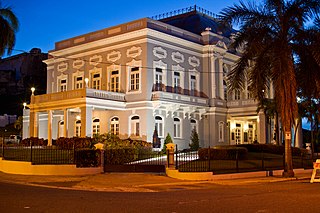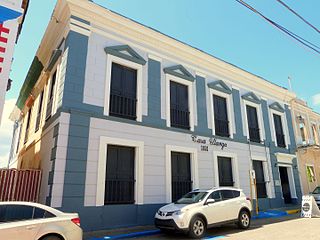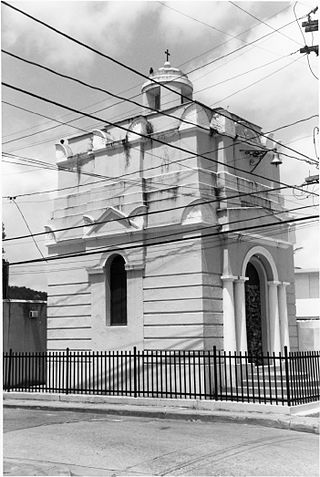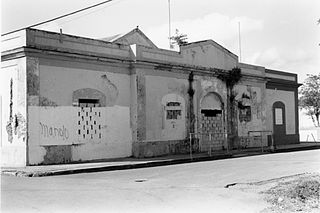
Humacao is a city and municipality in Puerto Rico located in the eastern coast of the island, north of Yabucoa; south of Naguabo; east of Las Piedras; and west of Vieques Passage. Humacao is spread over 12 barrios and Humacao Pueblo. It is part of the San Juan-Caguas-Guaynabo Metropolitan Statistical Area.

District Courthouse, also known as Museo de Arte de Aguadilla, in Aguadilla, Puerto Rico, was built in 1925. It was listed on the National Register of Historic Places in 1985, and to the Puerto Rico Register of Historic Sites and Zones in 2000.

The Parroquia del Espíritu Santo y San Patricio, constructed in 1645, is one of Puerto Rico's oldest Catholic parish churches. It is located in the main plaza of the municipality of Loíza, Puerto Rico. The church represents an ethnically distinct community characterized by a rich Afro-Hispanic cultural and folk craft tradition. The structure's massive walls and buttresses helped the building withstand flood and hurricanes and likewise provided the people of Loíza with shelter from such natural disasters. The church, named after Saint Patrick, was enlarged to its present size in 1729.

The Casa Roig Museum is a historic house museum and gallery in Humacao, Puerto Rico. It was designed as a residence for the wealthy sugar planter Antonio Roig by the prominent Czech architect and Puerto Rico resident Antonin Nechodoma (1877–1928) and built in 1920.

Antiguo Casino Camuyano is a building in downtown Camuy, Puerto Rico, which dates from 1910. It was listed on the U.S. National Register of Historic Places in 1984 and on the Puerto Rico Register of Historic Sites and Zones in 2000.

Edificio Oliver in Arecibo, Puerto Rico was built in 1914. The building houses government offices for the municipality of Arecibo.

The Jose V. Toledo Federal Building and United States Courthouse is a historic post office and courthouse located at Old San Juan, Puerto Rico. It is a courthouse for the United States District Court for the District of Puerto Rico. It is also the site for oral argument before the United States Court of Appeals for the First Circuit, when that court sits in Puerto Rico.

The Concatedral Dulce Nombre de Jesús or in English, Co-Cathedral of the Sweet Name of Jesus, is a Catholic cathedral located on the town plaza in Humacao, Puerto Rico. Along with the Catedral Santiago Apóstol in Fajardo it is the seat of the Diocese of Fajardo-Humacao.

The Antiguo Casino de Puerto Rico, located at Avenida Ponce de León 1 in San Juan, Puerto Rico, is a Beaux Arts architecture style building dating from 1917. It was listed on the National Register of Historic Places in 1977, and on the Puerto Rico Register of Historic Sites and Zones in 2000.

The Polvorín de Miraflores is an 18th-century structure in San Juan, Puerto Rico, specifically in the Isla Grande sector of Santurce, that served as an ammunition storage place for the Spanish military. The site was included in the National Register of Historic Places in 1984 and on the Puerto Rico Register of Historic Sites and Zones in 2000 for its historic importance.

Río Abajo is a barrio in the municipality of Humacao, Puerto Rico. Its population in 2010 was 7,495.

Antón Ruíz is a barrio in the municipality of Humacao, Puerto Rico. Its population in 2010 was 3,496.

Punta Santiago is a barrio and fishing community located in the municipality of Humacao, Puerto Rico. Its population in 2020 was 3,716. Located in the estuary of Humacao, Punta Santiago is famous for its fishing heritage, its iconic pier and Cayo Santiago, popularly known as Monkey Island after its Rhesus macaque population. The barrio is also the home of the Humacao Nature Reserve and the Punta Santiago Beach and Vacation Area. Punta Santiago is one of the most vulnerable barrios to flooding and complete destruction whenever hurricanes enter Puerto Rico through the area of Humacao.

The Logia Masónica Hijos de la Luz, on Avenida José C. Barbosa in Yauco, Puerto Rico, is a stuccoed masonry building constructed in 1894. It was listed on the National Register of Historic Places in 1988, and on the Puerto Rico Register of Historic Sites and Zones in 2001.

The Puerta de Tierra Phalanstery, simply known as El Falansterio and originally known as the Puerta de Tierra Tenement Group Project A, is a historic district and Art Deco public housing building complex from 1937 located in the Puerta de Tierra sub-district of San Juan, Puerto Rico.

Casa Ulanga, also known as the former Superior Court of Arecibo, is a historic building located at 7 Gonzalo Marín Street in the historic center of the Puerto Rican municipality of Arecibo. Due to its historic and architectural importance the building was added to the United States National Register of Historic Places on July 26, 1982, and to the Puerto Rico Register of Historic Sites and Zones in 2000.

The Guzmán Family Pantheon, also known as the Guzmán Hermitage, is a single story, lime-stuccoed, brick masonry funerary chapel located in Humacao Pueblo, in the Puerto Rican municipality of the same name. The structure was built in 1864 the Eclectic style, with Classic, Renaissance and Exotic architectural elements.

The Old Customs House of Humacao is a historic building located in Punta Santiago, in the municipality of Humacao, Puerto Rico. The structure was designed in the Spanish Colonial style, architecturally and typologically and finished in 1872 by the Department of Public Works of the Spanish Government in Puerto Rico. Until this time, the customs house was a temporary wooden building, so the need for a permanent structure made it possible that, in 1865, it was decided to construct the present building to serve as the new customs house at Punta Santiago.

The Pereyó House, formally referred to as the Palmira López de Pereyó Residence, is a historic Prairie School-style house from 1930 designed by Francisco Valinés Cofresí located in Humacao, Puerto Rico. It was added to the United States National Register of Historic Places in 1995, and to the Puerto Rico Register of Historic Sites and Zones on May 16, 2001.
The Antonia Sáez School is a former school located in Humacao, Puerto Rico. The Mission/Spanish Revival school building was added to the United States National Register of Historic Places in 1995, and to the Puerto Rico Register of Historic Sites and Zones on May 16, 2001. The structure also served as a marketplace between 1966 and 2004.





















